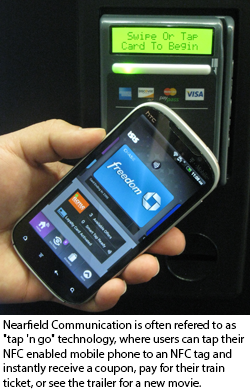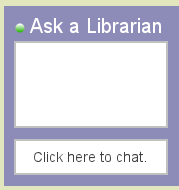Information Update - Fall 2012
Near Field Communication: A New Technology
- What is it?
Near Field Communication (NFC) is an emerging technology that allows objects, such as mobile phones, computers, tags and the like to exchange information wirelessly at very close range. How close? Just a few centimeters. It is often referred to as "tap 'n go" technology, where users can tap their NFC enabled mobile phone to an NFC tag and instantly receive a coupon, pay for their train ticket, or see the trailer for a new movie. Primarily used for mobile payment, NFC can be used in a wide variety of applications ranging from marketing to nutrition to health care and transportation. NFC serves as a way to connect the physical with the digital, potentially enhancing the way people interact with information. - How does it work?
NFC is an advanced form of RFID technology which uses the modulation of radio frequency fields to transfer and receive information. NFC requires two objects: an initiator or "reader" and a target. The target can be an NFC tag, sticker, credit card machine, or a mobile phone. NFC can perform as passive or active communication. This might sound very similar to a QR code tag that can be read with a mobile phone. However, with NFC, both the tag and the reader can be active, to create a two way peer-to-peer data exchange. For example, with mobile payment, you would not only be able to pay at the credit card machine with your mobile phone, you would also be able to apply coupons stored in your device to your purchase, receive in -store rewards and frequent shopper points, and receive electronic receipts on their mobile device, all in one transaction. Also, mobile phones can act as the reader and the target to exchange information both ways. So two friends can tap phones together and exchange data like contact information, payment, or even rewards within certain video games. - What can it do?
In addition to mobile payment, NFC tags can be embedded into posters to advertise events for users to tap and download to their personal calendar, RSVP, or share with their friends. NFC tags can be used for social networking. You can tap an NFC tag and "like" a particular business on Facebook or check-in to a location on Foursquare. Two users might tap their mobile phones together and become connected on LinkedIn, Facebook, or Twitter. NFC can be used to purchase and store mass transit tickets, scan your phone to board the train, scan a tag at the bus stop and see the current schedule, even parking meters can be NFC enabled to accept payments. Colleges and universities are utilizing NFC for access and identification. Students can program their NFC enabled phones to act as their key to enter their dorm or other restricted campus buildings. Students can also use their mobile phones to pay for meals in dining halls, buy tickets to campus events, and pay for laundry. Over time, these universities expect to replace student ID cards with NFC-enabled mobile phones. - What does it mean for libraries?
Should NFC become ubiquitous, libraries could use NFC to create a more cohesive collection by connecting physical library resources to relevant digital information. NFC tags could link physical books to eBooks with similar topics, databases for further research, or recommendations for additional materials.  NFC could also provide users with instant access to library contact information, virtual reference, or library hours. We might also utilize NFC on our advertisements for events, programs, awards and collections. NFC enabled mobile phones might replace library cards which would streamline library services for patrons. They can pay for printing, access a computer, and check items out with their mobile device. In the future, we might have self-check-out capabilities through our mobile devices. One library automation system already has a prototype that allows users to scan an NFC tagged book with their phone, to check the item out to themselves. If you'd like additional information on NFC, its technical specifications, capabilities, security and privacy concerns, and more on its impact on libraries, look for our article in the upcoming issue of the Journal of Web Librarianship
NFC could also provide users with instant access to library contact information, virtual reference, or library hours. We might also utilize NFC on our advertisements for events, programs, awards and collections. NFC enabled mobile phones might replace library cards which would streamline library services for patrons. They can pay for printing, access a computer, and check items out with their mobile device. In the future, we might have self-check-out capabilities through our mobile devices. One library automation system already has a prototype that allows users to scan an NFC tagged book with their phone, to check the item out to themselves. If you'd like additional information on NFC, its technical specifications, capabilities, security and privacy concerns, and more on its impact on libraries, look for our article in the upcoming issue of the Journal of Web Librarianship
—Sheli McHugh & Kristen Yarmey

